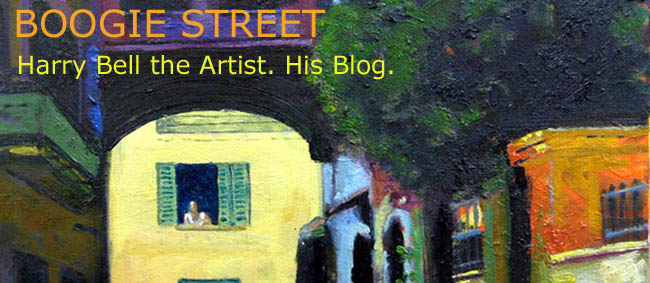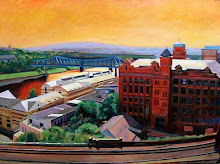I usually approach this onerous task by looking at what I've written before and seeing if it can be tweaked, enlarged or fused with another piece of fluff I've written to come up with a text that reads like it might possibly mean something.
I've just done it again for a proposed Figure 8 show in Darlington. We've been given the show, in fact, but the dates are yet to be arranged. Looks like four shows in the bag for 2008.
Anyway, this is what I ended up adding to our proposal:
The majority of my work is derived from the urban environment. I have long been fascinated by the play of light on buildings and my paintings have been constructed on strong compositional underpinnings based on the effects of sunlight and shadow. However, I am also increasingly concerned with the role of figures in urban spaces, where the mood may be mysterious and unsettling, or riotous and turbulent. The tonal approach I originally employed has given way to a brighter palette where colour can be seen to carry the main thrust of the painting. In addition, a greater emphasis on frontality and gesture signify a renewed concern for the integrity of the picture plane.
I'm not sure that this necessarily applies to the work I've been doing recently, some of which I've posted here. But one of the uses I find for such a Statement is to tell myself what it is I want to do, what direction I want the work to take. Whether it works that way remains to be seen.












6 comments:
Well, that's taught me a new word: frontality. Yes, I did look it up. I like it - and I like your statement. I think your work does speak for itself, but people's increasingly short attention spans need to be captured somehow in order to persuade them to stop and listen to it. I mean, look at it. I mean - you know what I mean!
hum, could you write my statement LOL! I hate doing them. Yours is really good and gives some insight to what you are trying to achieve with your work.
Well, first of all I can't write these damn things anyway. They wouldn't be necessary if gallery owners had the confidence to trust their own judgement, rather than need things explained to them.
Your statement talks about the "line tone texture" nuts and bolts of the process; the "play of light", the "tonal approach", the "brighter palette" and "composition". All good.
But I wonder if you should go on to talk about "meanings" / concepts. Perhaps relating what you do with the brush in context with the places you depict, thereby putting more emphasis on what you want your paintings to say, as well as what they look like.
Don't be afraid to be a little more pretentious. Give 'em something a potential client can impress their dinner guests with. Bright colours and shadows they know. Give 'em something a little more "artsy". Don't worry what a fellow artist might make of it; they're not the ones it's directed at.
Doctor Pam - lovely to have you back gracing these pages. Glad you were able to look up "frontality." None of my spellcheckers recognise it. But then, spellcheckers, eh?
Jafabrit - hard enough to write my own, without trying to do it for someone else!
Ian - maybe I'm just a shallow guy, but what my pictures say is something about the play of light, the mystery, the turbulence. There's nothing deeper I want to commit to in words and to do so would be to invent meaning for the work that would carry no conviction with me.
Jafabrit - hard enough to write my own, without trying to do it for someone else!
Oh DRAT!!!!
Yes, artist's statements are the toughest job we artists face, I think. And the "general" statement to cover all bases never works for me, in my mind, because each series is a bit different. I also find that one needs to change the language from "artspeak" for certain groups to "plainspeak" for others. I try for the middle, but it isn't easy. I agree it's good practice to keep writing it, and even making notes in one's sketchbook about what you are thinking about each work as you are making it.
Post a Comment